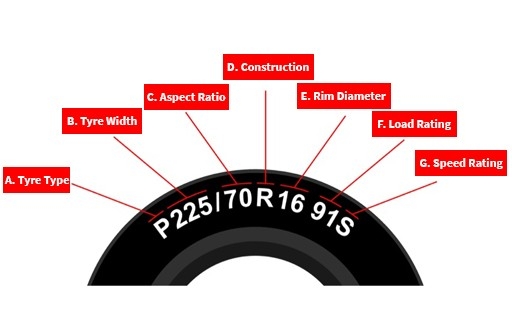These numbers, coupled with letters and symbols shaped on the sidewall, tell you the necessary information about your tyre.
Why is it important to learn them?
Knowing your tyre’s specifications lets you:
- Choose the best tyres for your vehicle.The sidewall bears the tyre brand and pattern. So, if you’re satisfied with your old tyres’ performance, you can choose to have similar tyres fitted.
- Guarantee your safety. Your tyres need to match your vehicle’s specifications. Incompatible tyres compromise not only your ride’s performance but also your safety.
- Properly maintain tyres. The numbers tell you many valuable things about your tyre, such as its speed rating, load index, how to install it, the maximum pressure it can take and many more.
- Get your money’s worth when you buy tyres. Aside from your tyre’s manufacturing date, the sidewall markings also show its safety standards and certifications. This way, you know you’ve made a good investment.
Your Basic Tyre Numbers Explained
A. Tyre Type
The first letter tyre marking explains what kind of tyre it is and for what vehicle.
P indicates a tyre for Passenger vehicles like cars, SUVs, minivans and smaller pickup trucks.
LT stands for Light Truck, a tyre compatible with 4×4 vehicles and light trucks and can carry and tow heavy loads. LT stands for Light Truck, a tyre compatible with 4×4 vehicles and light trucks and can carry and tow heavy loads.
ST stands for Special Trailer, a tyre used by trailers for travel, utility, and boats. If there’s no letter before the first number, you have a European metric-sized tyre. Though this tyre also uses millimetres to measure tyre width, it has a different way of calculating load and pressure values.
Why it matters: Tyre types have different purposes. While LT tyres are built for tough driving conditions, Passenger tyres are designed for lighter vehicles, providing a smooth and quiet ride.
B. Tyre Width
The first number you see on your tyre code indicates the width of the tyre in millimetres. Also called Section Width, Tyre Width is the distance from one sidewall to the other. Aside from your sidewall, the tyre size is visible on the driver’s door jamb, the vehicle’s manual, glove compartment, and petrol cap.
Why it matters: By looking at this specific number on your tyre code, its meaning is evident, serving as a gauge for your tyre’s grip, noise level, ride comfort, and rolling resistance. The wider your tyre, the better contact it makes with the ground. While this improves grip and lessens rolling resistance, it also increases road feedback and ride stiffness, even at higher speeds.
C. Aspect Ratio
The number after the tyre width and slash is read as a percentage and is the height of the tyre from the rim to the tread— in relation to the tyre width. So, if the number is 65, the tyre’s height is 65% of its width.
Why it matters: The higher the tyre’s Aspect Ratio, the taller its sidewall. Typically, trucks, buses, and some prestige cars have high Aspect Ratios for the tyre to accommodate more air, thereby boosting ride comfort. Meanwhile, tyres with shorter sidewalls may not be as comfortable to drive but have better handling and cornering abilities.
D. Construction
This letter indicates how manufacturers put together the tyre components such as the bead, sidewall, tread, belt, and carcass.
R stands for Radial, today’s most common tyre construction. Its rubber-coated plies or layers of steel and fabric are arranged perpendicular to the tread and parallel to each other to strengthen the tyre and maintain its shape. Radial Tyres provide better grip and durability while increasing ride comfort and lowering rolling resistance.
D indicates a Diagonal or Bias-Ply internal construction, with plies laid in crisscross patterns and at contradictory angles. This tyre is often used by port and terminal vehicles because of its heavy lifting and towing capabilities.
E. Rim Diameter
After the letter that stands for tyre construction is the Rim Diameter, measured in inches. This is the measurement taken from the wheel flange—or the rim’s protruding edge that secures the wheel to the axle—to its opposite side.
Why it matters: Your tyre’s Rim Diameter tells you its compatible wheel size. For example, a Rim Diameter of 15 inches means you should fit it to a 15-inch diameter wheel. However, racing and off-road enthusiasts like mixing and matching wheel and tyre sizes to boost comfort and performance.
F. Load Rating
Also called Load Index, the Load Rating indicates your tyre’s maximum load capacity while operating at its maximum permitted speed with proper tyre pressure. But the number on your tyre is merely a code, not the actual weight it can carry. To know the weight in kilograms, check our Tyre Load Index Table. For instance, a Load Rating of 89 means that your tyre can bear up to 580 kg.
Why it matters: A tyre with a lower Load Rating than your Original Equipment Manufacturer (OEM) tyre will not be able to carry the weight of your vehicle, passengers, and other equipment. This mistake may result in tire damage or, worse, an accident.
G. Speed Rating
A letter represents your tyre’s Speed Rating or Speed Index–the maximum speed you can safely drive your car when tyres are properly inflated and operating under load. A higher rating gives you better handling and control at increased speeds. To find out the corresponding rate of this symbol, take a look at our Tyre Speed Rating Chart. A speed rating of H, in particular, refers to a Speed Rating of 210 kph.
Why it matters: A Speed Rating that’s too low for your vehicle means that the tyre may overheat during fast drives and may result in a blow-out or a loss of control over your ride.
Stay tuned for our next blogpost!
Happy reading!
List of References
Tyroola, https://www.tyroola.com.au/guides/what-do-the-numbers-on-tyres-mean/, accessed 10 February 2024,

